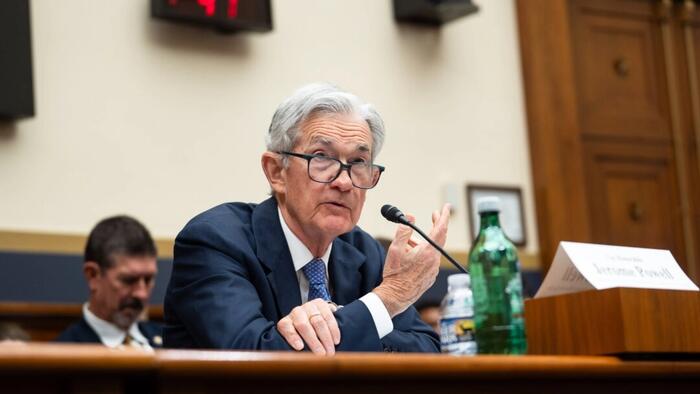


Authored by Tom Ozimek via The Epoch Times,
The Federal Reserve has adopted a draft proposal to ease a key capital requirement for the nation’s largest banks, aiming to reduce regulatory pressure that discourages them from holding low-risk assets such as U.S. Treasurys and to make it easier for these institutions to act as intermediaries in the Treasury market during times of stress, when liquidity is most needed.
At a public board meeting in Washington on June 25, Fed governors voted 5-2 to advance a long-awaited plan to modify the enhanced supplementary leverage ratio (eSLR)—a post–2008 financial crisis safeguard that requires global systemically important banks (GSIBs) to hold capital against all assets, regardless of risk. The proposal will now be published in the Federal Register and will be open for public comment for 60 days.
Fed chair Jerome Powell, speaking before the vote, endorsed the proposal and pointed to the banking sector’s overall strength. But he warned that the current leverage rule may be over-calibrated, potentially discouraging banks from holding safe assets and contributing to market strain.
“In the case of the leverage ratio, over-calibration may lead to diminished liquidity in the Treasury markets and other unintended consequences,” Powell said. “A leverage requirement functions best when it is generally a backstop to risk-based capital requirements,” Powell continued, adding that when leverage requirements are binding, they can discourage banks from participating in lower-risk lower-return activities that support the U.S. financial system and economy, such as Treasury market intermediation.
The proposed rule would replace the current flat leverage buffer of 2 percent at the parent bank level and 6 percent at the subsidiary level with a variable buffer based on each bank’s systemic risk score.
That change would reduce total capital requirements for America’s biggest banks by about 1.4 percent, according to Fed staff estimates. While capital requirements for bank subsidiaries would fall by a much larger 27 percent, most of that capital would remain locked within the banking group due to holding company rules and would not be available for shareholder payouts.
The reductions apply to Tier 1 capital—the core capital that includes common stock and retained earnings—used as a primary buffer to absorb losses during times of financial stress.
Supporters of the proposal say that the current version of the leverage rule has become too rigid—penalizing banks for holding safe assets and discouraging them from helping stabilize financial markets during periods of stress. Vice Chair for Supervision Michelle Bowman, who spearheaded the effort, called the recalibration a “sensible and timely” fix that restores the eSLR’s original purpose.
“The proposal will help to build resilience in U.S. Treasury markets, reducing the likelihood of market dysfunction and the need for the Federal Reserve to intervene in a future stress event,” Bowman said in prepared remarks. “We should be proactive in addressing the unintended consequences of bank regulation, including the bindingness of the eSLR, while ensuring the framework continues to promote safety, soundness, and financial stability.”
Fed governor Christopher Waller likewise endorsed the plan, saying that the current rule fails to distinguish between risky and safe assets.
“The leverage ratio treats a Treasury bond the same as a junk bond, but we know they’re not the same,” Waller said in prepared remarks, adding that the currently calibrated eSLR serves not as a backstop but as a binding requirement for some banks, imposing “unintended consequences for bank health,” with the added potential to impede market functioning.
“Re-working that incentive structure to address these unintended consequences of the current calibration makes sense,” said Waller, who also voted for the proposal.
Two Fed governors voted against the measure, warning that easing the rule could weaken safeguards that protect the banking system in a crisis.
Governor Michael Barr, the Fed’s former top regulatory official, criticized the proposal for significantly reducing bank-level capital and potentially encouraging firms to take on more risk or return capital to shareholders rather than expanding Treasury market activity.
Barr, who previously served as the Fed’s top regulatory official, said in prepared remarks that the proposal would significantly reduce capital across the banking system: by $210 billion at the holding company level, $280 billion at bank subsidiaries, $73 billion in total loss-absorbing capacity, and $132 billion in long-term debt requirements.
“Taken together, these changes would significantly increase the risk that a GSIB bank would fail, orderly resolution would not be possible, and the Deposit Insurance Fund would incur higher losses,” he said, referring to the fund at the Federal Deposit Insurance Corporation (FDIC), which is used to protect depositors and cover losses when insured banks collapse. Barr warned that with less capital on hand, large banks would be vulnerable in a crisis, potentially leaving the financial system—and taxpayers—more exposed.
Governor Adriana Kugler also opposed the measure, saying she might have supported a narrower recalibration at the holding company level but could not back the deeper capital cuts proposed for bank subsidiaries.
“Broker-dealers, not banks, are the subsidiaries of the G-SIB organizations that play the most critical role in intermediating Treasury markets through market making and securities financing activities,” Kugler said in prepared remarks. “Banks do not play the same role, and I am not convinced that the benefits to Treasury market intermediation from the change at the bank-level justify the significant proposed reductions in tier 1 capital requirements, especially in light of the potential for elevated financial stability risk.”
The proposal also invites public comment on potential alternatives, including whether to exclude certain Treasury assets entirely from the leverage ratio calculation, to further address concerns around U.S. Treasury market intermediation.
